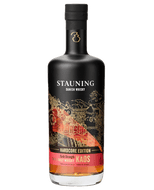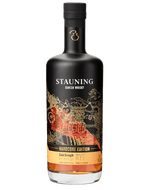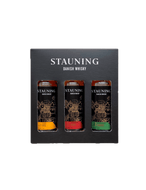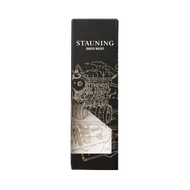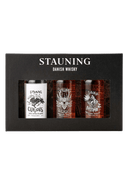HOW WE MAKE OUR WHISKY

There is no distillery in the world like Stauning
Glass, black metal, smoke, wood, copper, and flame. In 2018, Stauning opened up the doors to Denmark’s first purpose-built distillery. The clean, sharp angles nod to Danish aesthetics and architecture, while its burnt timber panelling and shape mirrors the fisherman's huts on the coast.
Inside you will see a myriad of copper stills, sitting fat-bellied with curious peaked hats. You start to count. 24 stills? Most distilleries make do with four – or less. But Stauning is not quite like most other distilleries.
To fully understand what this statement of a building is all about, you would have to go inside and follow the journey the locally grown barley and rye take to become one the finest whiskies in the world.
The Stauning team pushing the boundaries of whisky-making
The world is not short of distilleries these days. Walk around them and you’ll pick out similarities, maybe the odd quirk which sets them apart from their neighbour - the shape of a still perhaps, the type of wood used. There is no distillery in the world like Stauning.
Even though the modern distillery radiates innovation and 21st-century thinking, most of what goes on inside is, in essence, quite traditional. Because the process that the Stauningers use for whisky-making in the new larger facility is more or less the same that was used in the old, cosy farmhouse, which again originated back to the butchery methodology.


All great whiskies take something from their surroundings and the people who live there, then distill it all, somehow, into itself.
Stauning is no different. For that reason, only local produce is used for the unique West Coast whisky.
The barley and rye are grown within few kilometres of the distillery. 'We had some from a different part of Jutland, and it didn't smell the same - and was more expensive!' says Lasse, one the founders, and continues…
The decision is not simply about controlling every part of the process. Knowing the farmers deepens the connection between land and distillery, gives a more profound understanding of the ingredients… and a further tie to the New Nordic movement.
At Stauning every single grain is floor malted
The first part of the whisky-making process is malting, activating enzymes within the grain (be it barley or rye) which will convert its starches into fermentable sugars.
Traditionally, whisky-makers did their malting on the floor. These days, germination usually takes place in large temperature-controlled drums. However, not here. Again, the founders have found their own way to combine traditional craftsmanship with innovative engineering.


‘It’s how we started, so it is how we continue.’
When the machine starts, it moves slowly down the lane. Water is sprayed to wake the cereal up, while the arms gently begin to rotate to ensure even absorption. This is called steeping.
Here, the steeping and germination both take place on the floor. ‘We did steep in tanks, then asked why we couldn’t do it on the floor because it’s easier,’ says Lasse. ‘It didn’t change the flavour, or the yield (the amount of alcohol you get from one tonne of grain). Then he adds something which seems to sum up the Stauning approach. ‘It’s how we started, so it is how we continue.’
It's like stampeding horses charging at you in slow motion, a rippling hypnotic movement. The elegance and the artistry of the machinery is fascinating to behold, but the important thing is that it works.

Every year Stauning produce a batch which is wholly heather-smoked, adding a delicately perfumed aroma to the spirit, the only distillery in the world to do this.
The fragrance of the heathland
Coming to the village of Stauning, at times, you will smell the smoke and see it emanating from the kiln. The smoke is the result of peat being used as a heat source for drying and flavouring the malted barley or rye.
Peat is dead vegetation which cannot fully decompose due to it being held in waterlogged conditions. As a result, it is compressed into layers which ‘grow’ at approximately 1mm per year, and when cut and dried, can be burned as fuel. The nature of the composition of the peat will vary depending on what grew there thousands of years ago. Of course, only local peat from nearby bog is used to smoke the malted grains.
Here there are none of the medicinal aromas typical of Islay, or the heavier woodsmoke of peated malts from Scotland and much of Europe. Stauning's peat smoke instead is a gentle mix of earthiness, cacao, with a dried floral edge and a sweet back note.
From time to time, even local heather is used.
Mashing our way
The Stauning approach to the next part of the process is also unlike anything else in whisky. Mashing is where the grain (now ground to a coarse flour called grist) has hot water added to it. This reactivates the enzymes and completes the conversion of starches into sugars.
Back in the farm days, the team built a washing machine like device for the mashing. When scaling up, they needed a much larger machine. Rather than buying an industry standard, they managed to find a piece of giant machinery, in the Netherlands, imitating the washing machine technique.
The grist is mixed with water in a large tank, then pumped into a drum fitted with a screw and auger that carries the grain along its length. After being cooled, the grain is then dumped into a second vessel where more hot water is added. And then the process is repeated twice more.

After the mashing, it is time to start the fermenting and turn the mash into alcohol.
The fermentation at Stauning takes four days, which is fairly long by Scottish standards. The lengthy fermentation does not equate to a higher yield, but it develops more flavours. The fermented wort - very similar to beer - is now ready to be distilled.

All of this gives a fruity element which sits gently on top of that light cereal base note.

24 direct-fired pot stills
While most distilleries of Stauning's size would have 2 or 4 giant pot stills, you will find 24 small pots here. The logical choice when increasing capacity would have been to make the stills bigger, but as Lasse points out, 'making them larger would have had a huge impact on flavour. It's just not how we wanted to do it.'
The stills in the old farm were small, by necessity. To ensure the same character, they had to retain their shape and size. Increasing capacity, therefore, meant quintupling the number.
It could also have been decided to take out the gas burners and heating the stills with steam coils. After all, it's how 99% of the world's whisky is made, but not Stauning's.
Stauning started out with direct flames, so the founders knew they had to stick with that method. Not only out stubbornness, but because it adds character and creates a complex range of deep flavour compounds, like chocolate, caramel and roast nuts. Direct firing does this thanks to the fact that a still heated in this way will reach significantly higher temperatures (up to 650˚C) causing any solids in the wash - dead yeast cells, barley husks, sugar compounds, proteins, and dextrins - to stick to the inner surface of the copper in the same way steak placed on a hot griddle pan will start to brown. It is a Maillard type reaction.
At Stauning, the team uses double distilling in copper pot stills. First in a wash still and then in a spirit still. It is not the easiest solution, but the Stauningers certainly believe it is. The proof is in the bottles.


"Its rich mix of pine, butterscotch, and spice"
The new make spirit has to be placed in casks to be tamed and mellowed by oak. This strips away aggressiveness, adds flavour and colour from its reserves before those mingle and interact the spirit.
There are racks of casks which once held bourbon, adding notes of vanilla and coconut; brand new virgin American oak with its rich mix of pine, butterscotch, and spice for the rye.
Amongst them, a variety of ongoing experiments is scattered: casks which had held mezcal, cognac, calvados, or vermouth, also for the rye. Again, the curious mindset at Stauning blends tradition with rebellion.
Finally, the journey ends, and the spirit can be shipped out to bring pleasure and good taste to the world.



